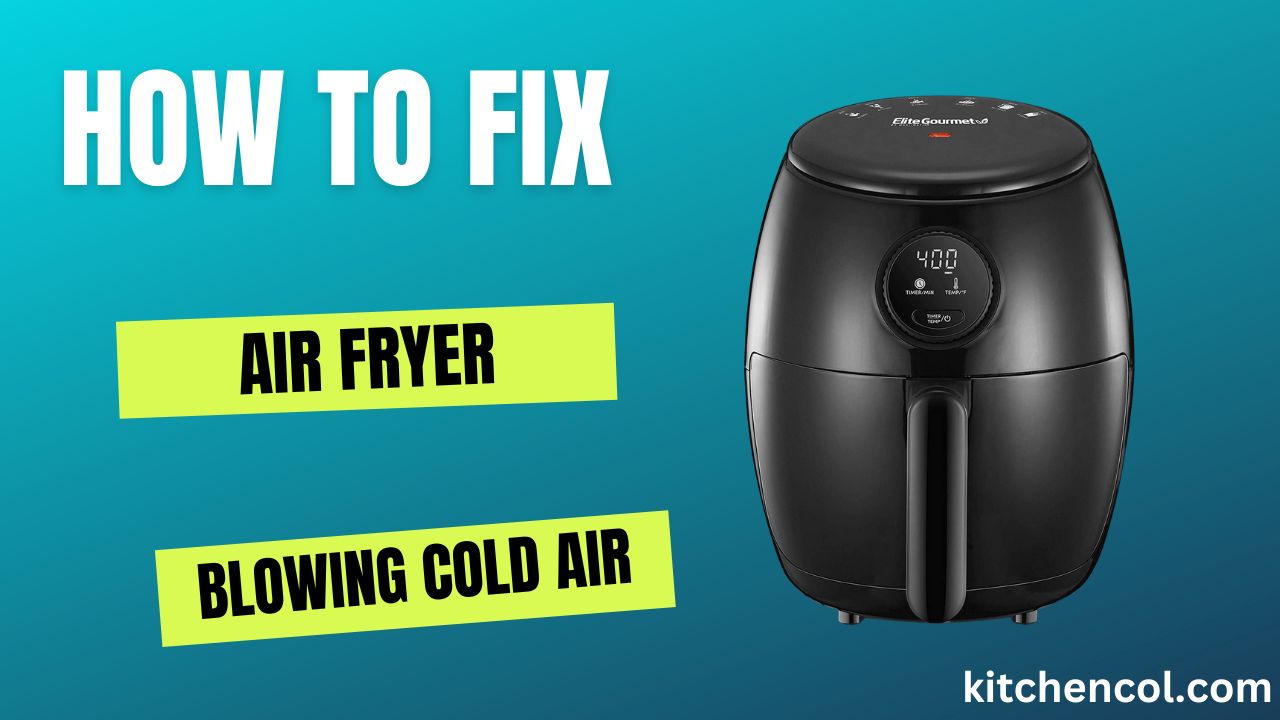Air fryers have become a beloved kitchen companion for health-conscious individuals and food enthusiasts alike, offering a quick and efficient way to achieve crispy and delicious dishes. However, what happens when your trusty air fryer starts blowing cold air instead of the expected warmth? In this guide, we delve into the perplexing issue of an air fryer blowing cold air and provide you with valuable insights into the possible causes behind this problem.
Whether you’re a cooking novice or a seasoned pro, understanding the workings of your air fryer and knowing how to troubleshoot common issues like this one can help you get back to enjoying your favorite crispy creations in no time.
Understanding How Air Fryers Work
Air fryers have revolutionized the way we cook, allowing us to indulge in our favorite fried foods with a fraction of the oil traditionally required. The magic behind their efficiency lies in a combination of rapid air circulation and heating elements.
Rapid Air Circulation:
Unlike traditional frying methods that submerge food in hot oil, air fryers rely on the circulation of superheated air. This is achieved through a powerful fan located near the top of the appliance. As the fan propels hot air downwards, it creates a whirlwind effect, enveloping the food from all angles. This consistent circulation ensures even cooking and a crispy texture without the need for excessive oil.
Heating Elements:
Central to the air fryer’s operation are its heating elements, typically located above and below the cooking chamber. These elements generate the initial burst of heat that warms the air inside the appliance. As the air heats up, it’s propelled by the fan, enveloping the food and cooking it evenly.

Importance of Hot Air:
The principle of hot air circulation is vital for the cooking process. When air fryers blow cold air instead, it disrupts this delicate balance. Hot air not only cooks the food but also helps in the Maillard reaction—a chemical process that creates the appealing browning and flavors characteristic of fried foods. It becomes difficult to get the proper texture and flavor without this essential component.
In the following sections, we’ll explore common reasons why your air fryer might blow cold air and how to troubleshoot each issue effectively. By grasping the fundamental mechanics of your air fryer, you’ll be better equipped to diagnose and resolve problems that hinder its performance.
Common Reasons for Air Fryer Blowing Cold Air
While air fryers are designed to simplify cooking and produce satisfying results, they can encounter issues that affect their performance, including blowing cold air instead of the expected warmth. Let’s delve into some common reasons behind this perplexing problem and explore how to address them.
Heating Element Malfunction:
The heating elements are the heart of the air fryer, responsible for generating the initial heat that warms the air. If these elements malfunction, they might fail to reach the required temperature, causing the air blown into the cooking chamber to remain cold.
Troubleshooting Tip:
Inspect the heating elements for signs of damage or malfunction. If you notice any issues, such as visible breaks or burnt areas, it’s likely that the elements need replacement. Consult your air fryer’s user manual or contact the manufacturer for guidance on obtaining and installing replacement heating elements.
Thermostat and Temperature Sensors:
Air fryers are equipped with thermostats and temperature sensors that regulate the cooking temperature. If these components become faulty, they can misread or fail to maintain the desired temperature, leading to cold air being blown into the cooking chamber.
Troubleshooting Tip:
Test the accuracy of your air fryer’s temperature settings by using an external thermometer. Place the thermometer inside the cooking chamber and compare its reading to the temperature set on the air fryer. If there’s a significant discrepancy, it indicates a problem with the thermostat or sensors. In this case, consider contacting the manufacturer’s customer support or professional repair service for further assistance.
Control Panel and Settings:
User error is another potential reason for an air fryer blowing cold air. If the control panel settings are incorrectly adjusted or the wrong cooking mode is selected, the appliance may not heat up as expected.
Troubleshooting Tip:
Double-check the temperature and time settings on the control panel to ensure they are correctly configured for the dish you’re preparing. Consult your air fryer’s manual if you’re unsure about the appropriate settings for different types of food. Additionally, make sure you’re using the appropriate cooking mode for your recipe.
By understanding these common reasons behind an air fryer blowing cold air and following the provided troubleshooting tips, you’ll be well-equipped to identify and address the issue effectively. In the next section, we’ll guide you through a step-by-step inspection and testing process to further diagnose the problem and potentially resolve it on your own.
Troubleshooting the Issue
If you find your air fryer blowing cold air instead of the expected warmth, there are several steps you can take to troubleshoot and potentially resolve the problem before seeking professional assistance. Let’s walk through a systematic approach to diagnosing and addressing the issue.
Step-by-Step Inspection:
- Power and Connection Check: Ensure your air fryer is properly plugged into a functioning power outlet. Sometimes, a loose connection can lead to inadequate heating.
- Heating Element Inspection: Carefully examine the heating elements for any visible damage, such as breaks or burns. If the elements are compromised, they might not be able to generate the necessary heat.
- Temperature Settings Verification: Double-check the temperature settings on the control panel. Make sure you’ve set the appropriate temperature for the dish you’re preparing.
- Cleaning Intake and Exhaust Vents: Dust and debris accumulation in the air fryer’s intake and exhaust vents can hinder airflow and heating efficiency. Gently clean these vents using a soft brush or cloth.
Testing with a Basic Recipe:
Select a simple recipe that requires a moderate cooking temperature and a short cooking time. This will help you test whether your air fryer is producing hot air as it should.
- Preheat Test: Preheat the air fryer to the desired cooking temperature. Allow it to run for a few minutes and then check the air inside the cooking chamber. If the air is warm, the preheat test is successful.
- Cooking Test: Place a small amount of food (such as bread slices or potato wedges) into the air fryer and set the timer for a brief cooking period. Monitor the cooking process closely, checking if the air inside the chamber remains warm throughout the cooking time.
Interpreting the Results:
- If the air fryer consistently blows cold air and fails to produce the expected warmth during both the preheat and cooking tests, it’s likely that there’s a technical issue with the heating elements, thermostat, or temperature sensors. Consider seeking professional repair assistance or contacting the manufacturer’s customer support.
- If the air fryer successfully produces hot air during the preheat and cooking tests, the initial issue might have been due to incorrect settings or a temporary glitch. Ensure you’re using the appropriate settings for different recipes and continue using your air fryer as usual.
By following this step-by-step troubleshooting process, you’ll gain valuable insights into whether your air fryer’s cold air issue is due to technical malfunctions or user error. Remember that safety is paramount, so exercise caution while inspecting the appliance. If the problem persists despite your best efforts, it might be time to explore seeking professional help, as discussed in the next section.
Seeking Professional Help
If your attempts at troubleshooting the issue of your air fryer blowing cold air yield no positive results, it might be time to consider seeking professional assistance. Here are two options to explore:
Manufacturer’s Support:
Reach out to the manufacturer’s customer support. They are well-versed in their product’s technicalities and can guide you through additional troubleshooting steps. If the problem is covered under warranty, they might arrange for repairs or replacement parts.
Professional Repair Services:
If your air fryer is no longer under warranty or requires extensive repairs, professional appliance repair services are a viable solution. Look for reputable technicians experienced in air fryer repairs. They can diagnose the issue accurately and provide cost-effective solutions, ensuring your appliance is back to its optimal functioning.
While seeking professional help may incur additional costs, it can save you the hassle of continued unsuccessful troubleshooting and potentially extend the lifespan of your air fryer. Always weigh the repair costs against the value of the appliance and your usage frequency to make an informed decision.
Maintenance and Preventive Measures
Preventing issues like an air fryer blowing cold air begins with proper maintenance and adopting preventive measures. By following these guidelines, you can extend the lifespan of your appliance and ensure its consistent performance:
Regular Cleaning:
Regularly clean your air fryer’s interior and exterior to prevent dust, grease, and food debris from accumulating. Clean the heating elements, fan, and vents as well. A buildup of dirt can hinder airflow and lead to heating problems.
Avoid Excessive Oil Usage:
While air fryers use significantly less oil than traditional frying methods, excess oil can still cause residue buildup. Use oil sparingly and clean the cooking basket thoroughly after each use.
Read and Follow the Manual:
The user manual provides valuable insights into proper usage, maintenance, and troubleshooting specific to your air fryer model. Follow the guidelines for optimal results and to avoid common mistakes.
Avoid Overloading:
Overcrowding the cooking basket can obstruct proper air circulation, leading to uneven cooking and temperature inconsistencies. Cook in batches if needed to ensure proper airflow.
Keep Vents Clear:
Ensure that the air intake and exhaust vents are unblocked to allow smooth airflow. Position the air fryer with enough space around it to prevent obstruction.
Gentle Handling:
Handle your air fryer with care, especially when cleaning or moving it. Rough handling can lead to internal component damage that affects its performance.
Regular Inspection:
Perform periodic checks of heating elements, fans, and other components to identify any signs of wear or damage. Early resolution of minor difficulties can stop them from developing into larger concerns.
By adopting these maintenance practices and preventive measures, you can minimize the likelihood of encountering issues such as cold air blowing from your air fryer. A well-maintained appliance not only delivers consistent results but also ensures a safe and enjoyable cooking experience.
Also Read: Air Fryer vs. Air Roast Ninja-A Detailed Guide and Comparison
Conclusion
In the world of modern cooking appliances, air fryers stand out for their efficiency and convenience. However, when faced with the unexpected problem of an air fryer blowing cold air, understanding its mechanics and troubleshooting techniques becomes invaluable.
By comprehending the importance of hot air circulation, identifying common issues like heating element malfunction or user error, and taking proactive steps in maintenance, you can overcome challenges and enjoy crispy and delicious dishes once again.
Whether through self-diagnosis, seeking manufacturer support, or opting for professional repair services, addressing the cold air issue ensures your air fryer remains a reliable and beloved tool in your culinary journey.

My name is Manan Bukhari and I am an expert in reviewing kitchen products for years. I have a passion for testing multiple gadgets especially related to home & kitchen. I love to spend my free time in resolving issues if I face some in any of my daily use things. I have fixed multiple gadgets of my home on my own without any assistance and that thing gave me confidence to make a blog on troubleshooting of items that are for daily use to assist you folks. Even my wife praises me for having such talent. I always explore new machines on my own because this thing fascinates me.



